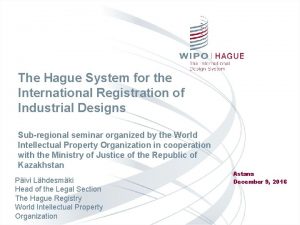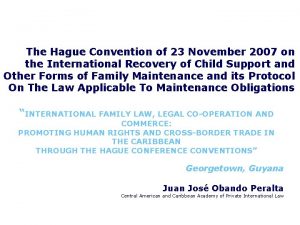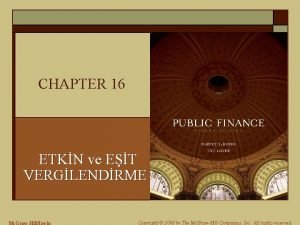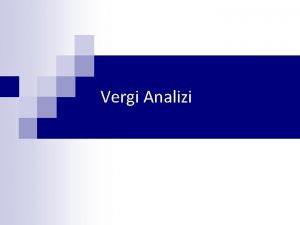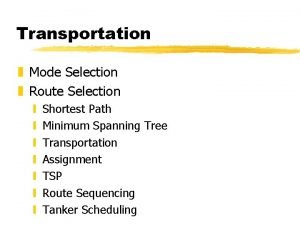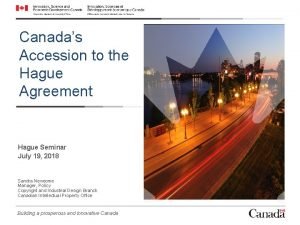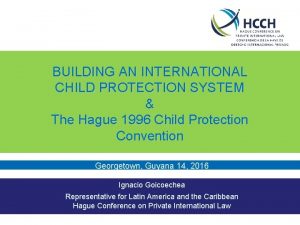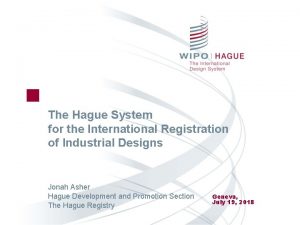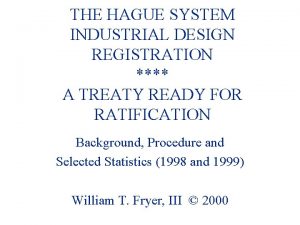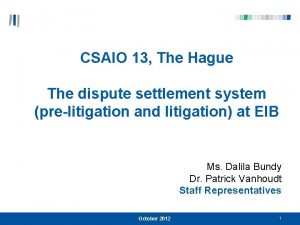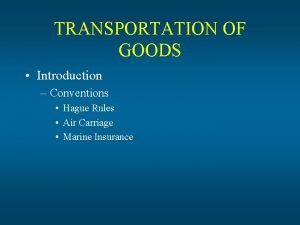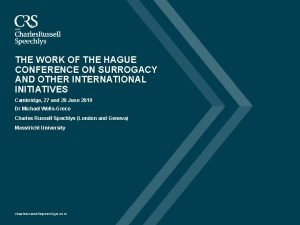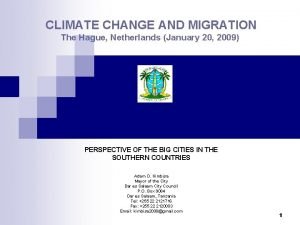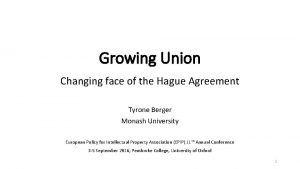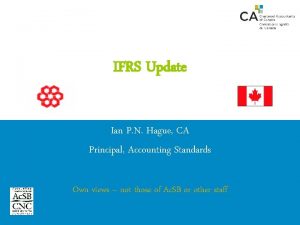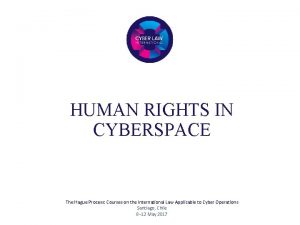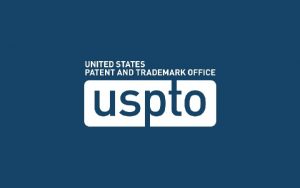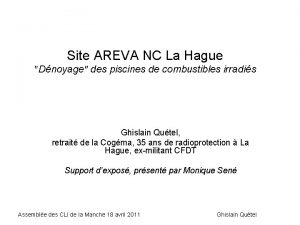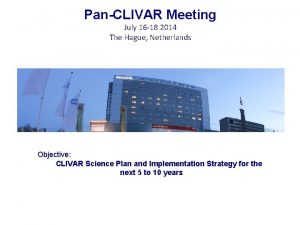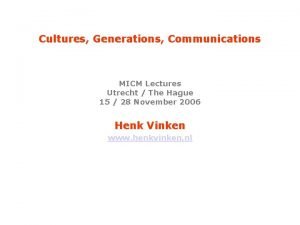Introduction to The Hague System for the International




















































- Slides: 52

Introduction to The Hague System for the International Registration of Industrial Designs Sub-regional seminar organized by the World Intellectual Property Organization in cooperation with the Ministry of Justice of the Republic of Kazakhstan Päivi Lähdesmäki Head of the Legal Section The Hague Registry World Intellectual Property Organization Astana December 9, 2016

Industrial Designs DM/074502 DM/083330 DM/081900

Why Protect Industrial Designs? Exclusive right to prevent unauthorized copying or imitation of the product Strengthening competitive positions of the company Protection of industrial designs Fair return on investment made in creating and marketing the product Encouraging fair competition and honest trade practices

Industrial Designs DM/074502 DM/083330 DM/081900

DM/090 275 DM/082 924 DM/085 377

Contents Going Global – Geographical Scope of the Hague System What is the Hague System? Main Features of the Hague System Trends in 2016 Specificities for Japan, the Republic of Korea and the United States of America Latest Developments

Going Global – Geographical Scope of the Hague System

Hague Union 52 Geneva Act (1999) (including EU and OAPI) 14 Hague Act (1960) 66 Contracting Parties 84 jurisdictions covered

Hague System: Foreseen Expansion

Geneva Act (1999) Recent Accessions The Kingdom of Cambodia (November 25, 2016) D. P. R. of Korea (June 13, 2016) Turkmenistan (December 16, 2015) United States of America (February 13, 2015) Japan (February 13, 2015) Republic of Korea (March 31, 2014) Potential Accessions China Russian Federation Morocco ASEAN countries Israel Canada Mexico Madagascar

Hague Union Members according to the most recent applicable Act Geneva Act (1999) • African Intellectual Property Organization, Albania, Armenia, Azerbaijan, Bosnia and Herzegovina, Botswana, Brunei Darussalam, Bulgaria, Cambodia, Croatia, D. P. R. of Korea, Denmark, Egypt, Estonia, European Union, Finland, France, Georgia, Germany, Ghana, Hungary, Iceland, Japan, Kyrgyzstan, Latvia, Liechtenstein, Lithuania, Monaco, Mongolia, Montenegro, Namibia, Norway, Oman, Poland, Republic of Korea, Republic of Moldova, Romania, Rwanda, Sao Tome and Principe, Serbia, Singapore, Slovenia, Spain, Syrian Arab Republic, Switzerland, Tajikistan, the former Y. R. of Macedonia, Tunisia, Turkey, Turkmenistan, Ukraine and the United States of America (52) Hague Act (1960) • Belgium, Belize, Benin, Côte d’Ivoire, Gabon, Greece, Italy, Luxembourg, Mali, Morocco, Netherlands, Niger, Senegal and Suriname (14)

Hague Agreement Hague Act (1960) Geneva Act (1999) • Common Regulations (1996), last revised: January 1, 2017 • Administrative Instructions (2002), last revised: July 1, 2014 • National Laws and Regulations

Hague Membership Status as of November 2016 (by most recent Act) 70 60 50 40 30 20 10 0 2003 2004 2005 2006 2007 2008 2009 2010 2011 2012 2013 2014 2015 2016 1999 Act 11 15 18 20 23 33 36 39 42 45 46 47 50 52 1960 Act 21 21 21 19 18 17 16 15 15 14

What is the Hague System? One to many relationships • File a single international application for a single international registration (IR) in which one or more Contracting Parties (CP) are designated “Bundle of Rights” • If no refusal, the resulting international registration has the effect of a grant of protection in each designated Contracting Party

Independent filings vs. Hague Route Direct/Paris Route The Hague System

Who Can Use the System? Domicile Nationality Attachment to a Contracting Party Real and effective industrial/commercial establishment Habitual residence Geneva (1999) Act only

Main Features of the Hague System Simplicity The Hague System enables holders to obtain protection for their designs with a minimum of formality Cost-effectiveness Payment of a single set of fees in one currency Efficiency Considerable facilitation of the subsequent management of the registration Flexibility Right holders have more opportunities in targeting national, regional or global markets

Hague System is a Procedural Arrangement Issues such as: the conditions for protection the refusal procedure to be applied when deciding whether a design may be protected the rights which result from protection are governed by the law of each Contracting Party designated in an international registration

The International Application In English, French or Spanish May be filed directly with the International Bureau through the E-filing interface but also on paper May comprise several different designs up to a maximum of 100 if they belong to the same class of the International Classification (Locarno) One set of fees (in CHF) is to be paid

The Hague System Procedure: Role of the International Bureau Formal examination Recording in the International Register Sending the certificate to the holder Publication in the International Designs Bulletin Notification to members through the publication in the Bulletin If the International Bureau finds that the international application does not fulfill the applicable requirements, it invites the applicant to make the required corrections within three months from the date of invitation sent by the International Bureau International registration has the same effect as a regularly-filed application in all designated Contracting Parties

The Hague System Procedure (II) Refusal by a designated Contracting Party on same substantive grounds as for national/regional filings must be communicated within time limit effect limited to territory of the member that has refused International registration (where not refused) no refusal = same rights as a local design registration a bundle of independent national/regional rights advantages of central management

The Hague System Procedure (III) Duration of protection: five years Renewable at least once (1960 Act) or twice (1999 Act) Longer renewal period, if allowed by the law of the designated Contracting Party

2016 Some General Trends under the Hague System

Trends: Continuing Growth 2015: • 3, 581 international registrations contained 14, 484 designs; • Growth (%) 2014 -2015: +32. 5% registrations, +7. 3% designs 2016 (until October 31): • 4, 357 international registrations contained 14, 821 designs • Growth (%) to same period in 2015: +56, 7% registrations, +30, 4 % designs

International Applications per Month Trend in Hague Filing - Monthly 520 470 420 370 320 270 220 170 120 янв 2011 янв 2012 янв 2013 янв 2014 (rolling average 1 year) янв 2015 янв 2016 янв 2017

2016 Some General Trends under the Hague System Who is filing?

Trends: 2016 (until October 31): TOP 10 origins (designs recorded by country of address of the holder) Growth Germany Switzerland Republic of Korea United States of America Netherlands France Italy Japan Turkey Denmark 3017 2159 1628 1118 1017 1044 946 662 402 332 22% -21% +86% +127% +118% +10% +15% +421% +102% +196%

Diversification of Origins Percentage of total applications by origin (applicant’s address) 120% 100% TR GB 80% JP NL 60% US IT FR 40% KR DE CH 20% 0% 2007 2008 2009 2010 2011 2012 2013 2014 2015 2016 (January -June)

Trends: 2016 (until October 31): TOP 10 applicants by designs Hague – TOP 10 applicants by designs Country Applications Designs Fonkel Meubelmarketing NL 28 848 SAMSUNG ELECTRONICS CO. , LTD. KR 281 743 LG ELECTRONICS INC. KR 565 600 SWATCH AG (SWATCH SA) (SWATCH LTD. )CH 108 311 Volkswagen Aktiengesellschaft DE 60 309 RENAULT s. a. s. FR 43 289 The Procter & Gamble Company US 56 277 Microsoft Corporation US 27 201 Wenko-Wenselaar Gmb. H & Co. KG DE 16 180 HERMES SELLIER FR 24 147

2016 Some General Trends under the Hague System Where is protection sought?

Trends: 2016 (until October 31): TOP 10 Designations (designs recorded by Designated Contracting Party) European Union Switzerland Turkey United States of America Norway Singapore Ukraine Republic of Korea Japan Morocco 11626 6996 4989 3538 2562 2357 2291 2064 1893 1619 Growth +23% -1% +8% +285% -3% +6% +10% +258% -1%

Applications by Designated CP Percentage of applications by designated CP 100% 90% 80% MA 70% JP 60% UA 50% SG 40% NO 30% KR 20% US TR 10% CH ne ) nu ar y- Ju 20 15 (Ja 16 20 20 14 20 13 20 12 20 11 20 10 20 09 20 08 20 07 0% EM

January-September 2016: Five Most Popular Classes in International Registrations Class 14 Recording, communication or information retrieval equipment 551 registrations (14. 1%) Class 12 Means of transport or hoisting 339 registrations (8. 7%) Class 10 Clocks and watches and other measuring instruments, checking and signaling instruments 266 registrations (6. 8%) Class 15 Machines, not elsewhere specified 324 registrations (8. 3%) Class 6 Furnishing 249 registrations (6. 3%)

Cost-effectiveness Payment of a single set of fees in one currency

Amount of Fees Paid per International Registration (2015) IR % 1570 43. 8% 1165 32. 5% 426 11. 9% 259 7. 2% 161 4. 5%

International Registrations in Force in the International Register (on December 31, 2015)

2016 Some General Trends under the Hague System Decisions by Offices

Decisions by Offices of Designated Contracting Parties in 2016 (until October 31) 4670 Statements of Grant of protection +58, 4% increase to the same period in 2015 1506 Refusals of protection +884, 3% increase to the same period in 2015 (153) 146 Withdrawals of refusals (in the same period in 2015: 3)

Specificities for Japan, the Republic of Korea and the United States of America

US, JP and KR Specificities Declarations Ro. K JP US Individual Fees (X) X X X Y No Deferment Unity of design X X Oath Claim Specific Views Considerations X Ro. K X JP Y Duty of Candor Exception to Lack of Novelty Principal & Related Designs US Y Y X = Checked and enforced by the IB – no omission possible

Designs per International Registration

Grounds of refusals by JPO (from March 24 th, 2016 to October 31 st, 2016) Source: Internal (unofficial) statistics Number of refusals by JPO Total Grounds for Refusal 519 designs 671 (100%) (in 254 international registrations) Main grounds of refusals 1. Insufficient Disclosure 259 designs (38. 6%) 2. Lack of Novelty 183 designs (27. 3%) 3. Ambiguous/broad indication of product 83 designs (12. 4%) 4. Conflicting Appl/Regis 40 design (5. 9%) Multiple refusal grounds can be listed for why a design was refused, as such the total grounds for refusal can be much higher than the amount of designs.

Grounds of refusals by KIPO (from January 12 th, 2015 to October 31 st, 2016)Source: Internal (unofficial) statistics Number of refusals by KIPO Total Grounds for Refusal 1591 designs 2081 (100%) (in 553 international registrations) Main grounds of refusals 1. Insufficient disclosure 1059 designs (50. 8%) 2. Conflicting Application/ Registration 334 designs (16%) 3. Lack of Novelty 173 designs (8. 3%) 4. Ambiguous/broad indication of Product 119 designs (5. 7%) Multiple refusal grounds can be listed for why a design was refused, as such the total grounds for refusal can be much higher than the amount of designs.

Unity of Design refusals by USPTO (from November 6 th, 2015 to October 31 st, 2016)Source: Internal (unofficial) statistics Number of refusals 579 designs (in 117 international registrations) Grounds of the Refusals 1. Unity of Design as the only ground 450 designs 95 international registrations 2. Other grounds in addition to Unity of Design 129 designs 22 international registrations Refusal on the ground of Unity of Design enables the refusal of the effect of the International Registration in its entirety, pending restriction to one design Article 13(2) Geneva Act (1999)

Grounds of refusals by USPTO Source: Internal (unofficial) statistics (from November 6 th, 2015 to October 31 st, 2016) Number of refusals by USPTO 267 designs (in 135 international registrations) Main grounds of refusals 1. Insufficient Disclosure 177 designs (32. 5%) 2. Unity of Design 129 designs (23. 7%) 3. Definition of Design 17 designs (3. 1%) 4. Others 13 designs (2. 4%) Total Grounds for Refusal 545 (100%) Multiple refusal grounds can be listed for why a design was refused, as such the total grounds for refusal can be much higher than the amount of designs.

Priority Documents Republic of Korea • Priority documents may be attached to the IA at the time of filing. • When failed to attach the priority documents to the IA, these documents shall be submitted directly to the KIPO through a local agent within three months of publication of the IR. Japan • Original priority documents have to be sent directly to the JPO through a local agent within three months of publication of the IR. United States of America • Original priority documents have to be sent directly to the USPTO at the latest before “the date the issue fee is paid”.

Latest Developments Regularization of international applications online (since March 2016) Guidance on preparing and providing reproductions in order to forestall possible refusals on the ground of insufficient disclosure of an industrial design by Examining Offices* New Hague Express Database since January 2015 Improvement of E-filing interface Developments in the legal framework * http: //www. wipo. int/edocs/hagdocs/en/2016/hague_2016_9. pdf

Guidance on Preparing and Providing Reproductions Available from 10 August 2016 at: English: http: //www. wipo. int/export/sites/www/hague/en/how_to/pdf/guidance. pdf French: http: //www. wipo. int/export/sites/www/hague/fr/how_to/pdf/guidance. pdf Spanish: http: //www. wipo. int/export/sites/www/hague/es/how_to/pdf/guidance. pdf

Hague Express / Global Design Database

Legal Developments Sixth session of the Working Group on the Legal Development of the Hague System, June 20 to 22, 2016 Rule 5 of the Common Regulations, as amended will come in force on January 1, 2017: «Safeguard mechanism» in respect of failure in electronic communication with the International Bureau; Amendments to Rules 14, 21 and 26 will come into force once the IT infrastructure is ready.

General Advantages of the Hague System (international route) National/regional route one Office for filing one language many Offices for filing many languages one currency many currencies one international registration many registrations one renewal one modification foreign attorney or agent (first needed if refused) many renewals many modifications foreign attorney or agent (first needed at filing)

Thank You www. wipo. int/hague/en
 Hague system fee calculator
Hague system fee calculator Hague convention
Hague convention Martin hague
Martin hague Adoption learning partners hague training
Adoption learning partners hague training Corlett hague kuralı
Corlett hague kuralı Corlett hague kuralı
Corlett hague kuralı Security products the hague
Security products the hague Hague line
Hague line Kontinuitetshantering i praktiken
Kontinuitetshantering i praktiken Typiska drag för en novell
Typiska drag för en novell Nationell inriktning för artificiell intelligens
Nationell inriktning för artificiell intelligens Ekologiskt fotavtryck
Ekologiskt fotavtryck Shingelfrisyren
Shingelfrisyren En lathund för arbete med kontinuitetshantering
En lathund för arbete med kontinuitetshantering Kassaregister ideell förening
Kassaregister ideell förening Tidbok för yrkesförare
Tidbok för yrkesförare A gastrica
A gastrica Vad är densitet
Vad är densitet Datorkunskap för nybörjare
Datorkunskap för nybörjare Tack för att ni lyssnade bild
Tack för att ni lyssnade bild Debattinlägg mall
Debattinlägg mall Delegerande ledarstil
Delegerande ledarstil Nyckelkompetenser för livslångt lärande
Nyckelkompetenser för livslångt lärande Påbyggnader för flakfordon
Påbyggnader för flakfordon Kraft per area
Kraft per area Svenskt ramverk för digital samverkan
Svenskt ramverk för digital samverkan Kyssande vind
Kyssande vind Presentera för publik crossboss
Presentera för publik crossboss Jiddisch
Jiddisch Vem räknas som jude
Vem räknas som jude Klassificeringsstruktur för kommunala verksamheter
Klassificeringsstruktur för kommunala verksamheter Luftstrupen för medicinare
Luftstrupen för medicinare Bästa kameran för astrofoto
Bästa kameran för astrofoto Centrum för kunskap och säkerhet
Centrum för kunskap och säkerhet Byggprocessen steg för steg
Byggprocessen steg för steg Bra mat för unga idrottare
Bra mat för unga idrottare Verktyg för automatisering av utbetalningar
Verktyg för automatisering av utbetalningar Rutin för avvikelsehantering
Rutin för avvikelsehantering Smärtskolan kunskap för livet
Smärtskolan kunskap för livet Ministerstyre för och nackdelar
Ministerstyre för och nackdelar Tack för att ni har lyssnat
Tack för att ni har lyssnat Vad är referatmarkeringar
Vad är referatmarkeringar Redogör för vad psykologi är
Redogör för vad psykologi är Stål för stötfångarsystem
Stål för stötfångarsystem Atmosfr
Atmosfr Borra hål för knoppar
Borra hål för knoppar Orubbliga rättigheter
Orubbliga rättigheter Hur räknar man standardavvikelse
Hur räknar man standardavvikelse Tack för att ni har lyssnat
Tack för att ni har lyssnat Steg för steg rita
Steg för steg rita Ledningssystem för verksamhetsinformation
Ledningssystem för verksamhetsinformation Tobinskatten för och nackdelar
Tobinskatten för och nackdelar Blomman för dagen drog
Blomman för dagen drog
